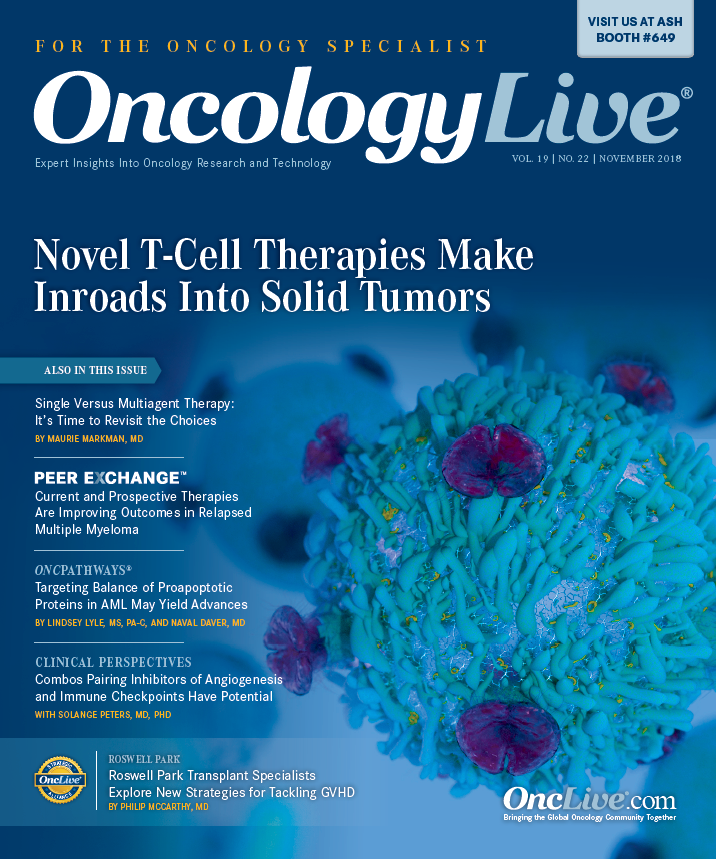Single Versus Multiagent Therapy: It's Time to Revisit the Choices
Maurie Markman, MD discusses the importance of objective evidence when using a combination approach as opposed to a single-agent treatment.
Maurie Markman, MD

Maurie Markman, MD
The fundamental goal of all antineoplastic therapeutic strategies is to favorably influence clinically meaningful outcomes. This may include, depending on the setting, an improvement in overall survival or time to subsequent progression of the disease process, the reduction or elimination of cancer-related symptoms, or a delay in the development of such symptoms.
Shrinkage of a tumor mass observed in an imaging study (eg, retroperitoneal lymph nodes) or a decrease in a measurable serum biomarker (eg, CA-125) demonstrates a biological effect of the strategy on the malignant disease process and is likely to be welcome news to patients and their families. However, one must question the clinical relevance of such observations unless there is also evidence that these biological effects influence 1—or hopefully more—of the previously noted survival or symptom outcomes.
These considerations become more pressing when it comes to the choice between combination and single-agent therapies. Patients, oncologists, and other interested parties, such as healthcare systems and third-party payers, should inquire about the objective evidence supporting the clinical superiority of a combination approach, especially because this strategy is likely to be more toxic and highly likely to be more expensive than single-agent treatment. Today, the cost of each antineoplastic drug can easily exceed $10,000 a month. And adverse events (AEs) associated with a multiagent approach encompass the unique components of the individual drugs, the additive effects of overlapping AEs (eg, bone marrow suppression, mucositis), and possible unknown or underappreciated negative synergistic influences of the components.
Finally, one must consider the not uncommon situation in which an individual patient with cancer shows evidence of biological benefit, such as imaging of shrinkage of a tumor mass, and clinical benefit, such as a decrease in abdominal pain, following delivery of a multiagent treatment program but also exhibits excessive toxicity. With single-agent therapy, the subsequent course of action will be fairly clear, with the oncologist’s reducing the dose or modifying the schedule (or both) for future treatments. But how should this situation be handled if more than 1 agent is being used?
Ovarian Cancer Provides Multiagent Example
Although one might argue that the dose of both drugs should be reduced or the schedule modified, what if only 1 of the agents is actually responsible for the majority of or all the observed benefit and removing the inactive drug would be a more rational approach than reducing the dose of both agents? Of course, in this situation it would simply not be possible to know the answer to this potentially highly clinically relevant question; the intent of highlighting this issue here is solely to emphasize the added complexity associated with optimizing individual patient care when employing multiagent antineoplastic therapy.The intent of this commentary is not to suggest the lack of clinical utility of multiagent treatment, compared with single- agent therapy in the management of malignant disease. Numerous examples of the superiority of this basic approach in terms of improving overall survival can be provided in many clinical settings.
Chronic Disease May Change Picture
A wonderful example in my area of clinical interest is the landmark study that combined 1 of 3 single-agent cytotoxic drugs (paclitaxel, topotecan, or pegylated liposomal doxorubicin) with the antiangiogenic agent bevacizumab (Avastin) in the management of platinum-resistant ovarian cancer.1 Not only did the combination regimen with bevacizumab produce a highly statistically significant and clinically relevant improvement in time to disease progression compared with single-agent chemotherapy, but there was also evidence of a more favorable impact on cancer-related symptoms such as pain. Further, subgroup analysis revealed that the addition of bevacizumab favorably influenced outcomes when added to all 3 single agents, strongly suggesting the generalizability of its positive impact when combined with cytotoxic chemotherapy in this clinical setting. Finally, it is notable that the agents being combined in this regimen were hypothesized not only to possess fundamentally different mechanisms of biological activity but also to be potentially synergistic when delivered in combination, rather than simply be additive in their clinical effects.However, it is important to acknowledge that the focus of care for many advanced or metastatic cancers is beginning to change from an acute illness management model to one in which the malignancy is considered as a very complex, life-threatening, likely ultimately fatal, but also more chronic illness.
In the former circumstance, although antineoplastic therapy will potentially be delivered initially with curative intent or at least to substantially prolong survival, it will also be administered over a limited period, likely measured in months. In the chronic illness model, such therapy may indeed improve survival, delay the time to subsequent disease progression, and favorably affect symptoms, but it may be delivered over a far more extended period of time, possibly for years.
It is in this new management paradigm that one must ask about the superiority of the combination therapy approach versus optimal sequencing of single agents designed to (a) favorably affect the natural history of the malignancy in an individual, including improving survival, and (b) minimize the AEs of treatment while permitting the patient to experience the best possible quality of life—as defined by the patient—during their cancer journey.
Perhaps it is time for the oncology research community to explore more fully the clinical utility of a strategy that focuses on improving sequential single-agent therapy—instead of constantly attempting to combine expensive and toxic antineoplastic agents—through the use of on-label or off-label commercially available drugs as well as with novel strategies being introduced into the clinical trials arena.
Pujade-Lauraine E, Hilpert F, Weber B, et al. Bevacizumab combined with chemotherapy for platinum-resistant recurrent ovarian cancer: the AURELIA open-label randomized phase III trial [erratum in J Clin Oncol. 2014;32(35):4025]. J Clin Oncol. 2014;32(13):1302-1308. doi: 10.1200/JCO.2013.51.4489.




